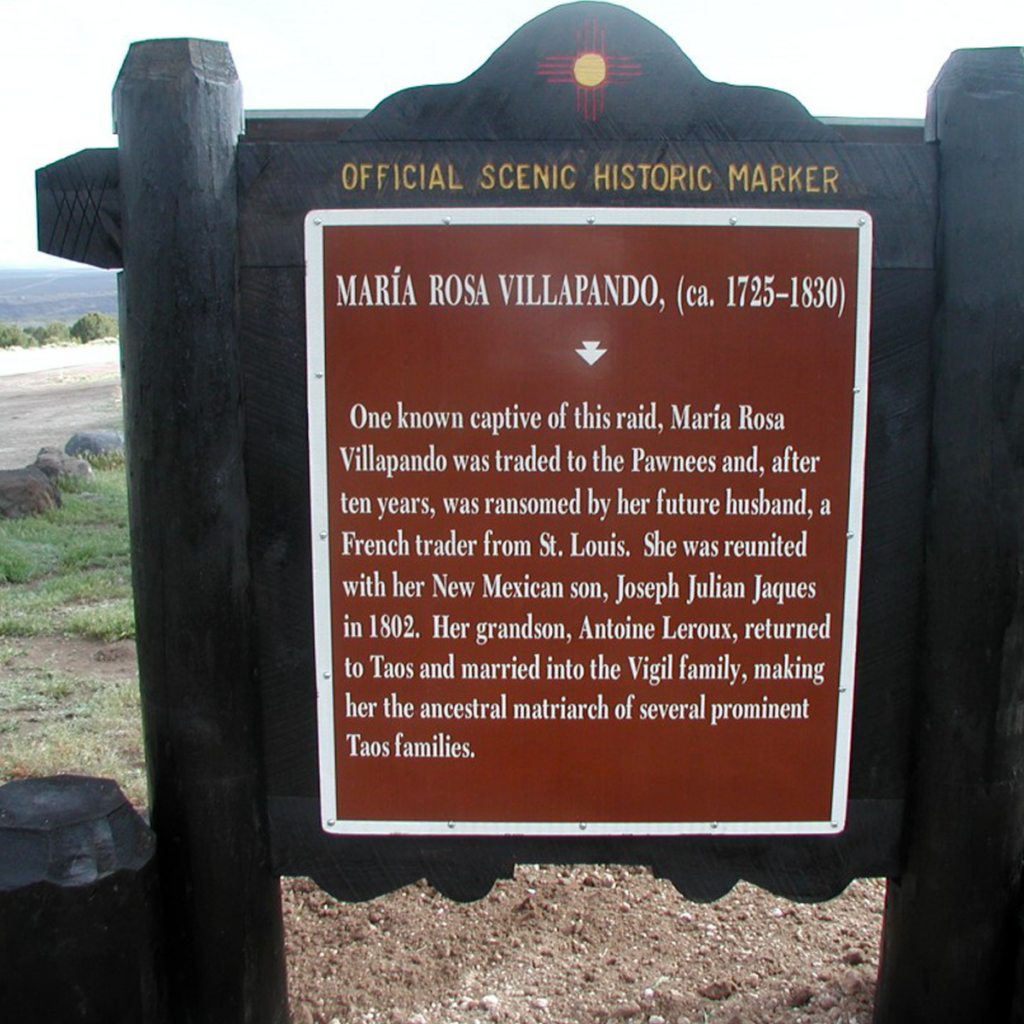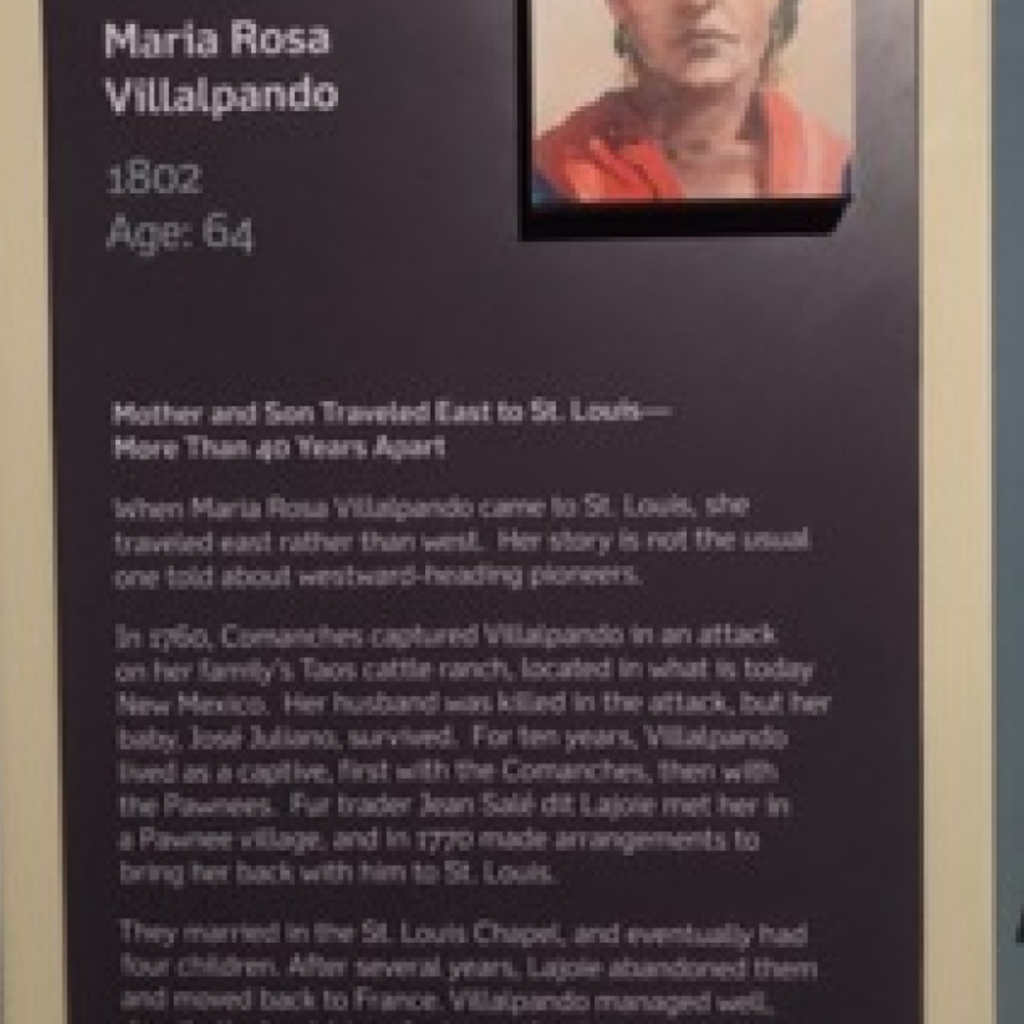Maria Rosa Villapando historic marker.
Photo Credit: Courtesy of New Mexico Historic Women Marker Program.
On the New Mexico frontier during the 17th and 18th centuries, Hispanic and Indigenous communities regularly raided each other, suffering enormous consequences. Thousands of women and children were taken captive. Most were never returned. Maria Rosa Villapando was one of these women.
From the seventeenth century into the nineteenth century, raiding and trading human beings, especially women and children, occurred with regularity in New Mexico. Native Americans took and traded human captives among themselves as well as in the communities in north-central New Mexico. Captives were necessary for religious purposes, menial tasks, and trade. Some captives were traded at trade fairs held at Taos, Abiquiu, and Pecos, where captive Hispanics were traded back to their own society or captive Indians from as far away as Nebraska were traded into New Mexican society. Many of these latter people remained in New Mexican society. They and their descendents became known as genízaros in New Mexico.
Many Hispanic punitive expeditions took Native captives. Many of New Mexico’s early governors illegally ran sweatshops of captive Indians. They also were involved in illegally trading captives south into Mexico.
The Diné (Navajo) raided western New Mexican settlements incessantly. At one time their raids successfully depopulated the Rio Puerco Valley, which they saw as a part of their homeland. Today, the descendents of many of these captives form a Mexican Clan in the Diné Nation.
María Rosa Villalpando is one case study. Taken in a Comanche raid on Ranchos de Taos in 1760, she was traded to the Pawnee tribe, with whom she lived for ten years. During that time she had a son and met a French trader who fathered her third child, ransomed her, and took her to the new village of St. Louis, where they were married in 1770. She and her husband had three more children.
After twenty-two years of marriage her husband went to France and never returned. Ten years later, in 1802, Maria Rosa’s first child, Joseph Julian Jacques, a son from New Mexico who survived that long-ago raid, crossed the plains to visit his mother. She acknowledged him and made an estate settlement with him.
María Rosa Villalpando died on July 27, 1830, one month short of 70 years after she was taken captive in New Mexico. One of her St. Louis grandsons, Antione Leroux, moved to Taos in 1824 and married into the New Mexican Vigil family.
Today, the Taos Valley has many people with the surname Jacques, Villalpando, and Leroux, all of whom are distant cousins and descendents of María Rosa Villalpando. The story of that infamous 1760 raid is re-enacted regularly in a communal ritual, a conquest romance of “Los Comanches,” in many northern New Mexican villages.
The raiding described above was a real danger of living on New Mexico’ frontier during the 17th and 18th centuries. Hispanic, Pueblo, and Nomadic peoples routinely raided each other and suffered the consequences.
Sources:
Brooks, James F. Captives & Cousins: Slavery, Kinship, and Community in The Southwest Borderlands. Chapel Hill: University of North Carolina Press, 2002.
Hackett, Charles Wilson, ed. Historical Documents Relating to New Mexico, Nueva Vizcaya, and Appraches Thereto. Washington, DC: Carnegie Institution, 1923-37.
Lamadrid, Enrique R. Hermanitos Comanchitos: Indo-Hispano Rituals of Captivity and Redemption. Albuquerque: University of New Mexico, 2003.
Thomas, Alfred B., ed. Forgotten Frontiers: A Study of the Spanish Indian Policy of Don Juan Bautisata de Anza Governor of New Mexico, 1777-1787. Norman: University of Oklahoma Press, 1932.
Directions:
Maria Rosa Villapando
Taos County
Activist |
Mexican Period (1821 - 1848) | Spanish Colonial (1540 - 1821) |
North Central








